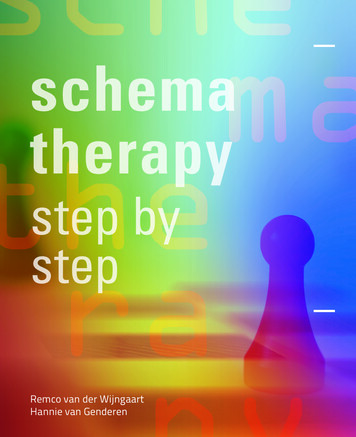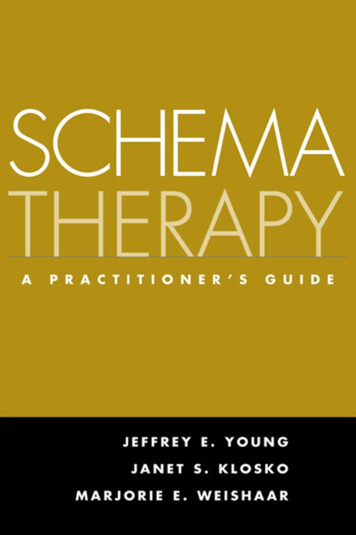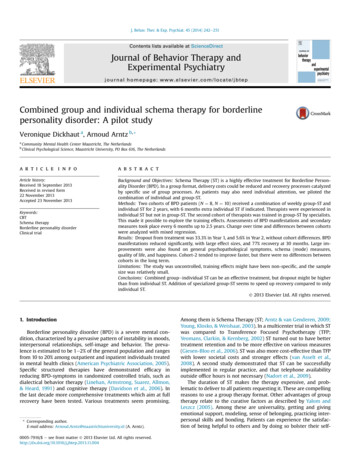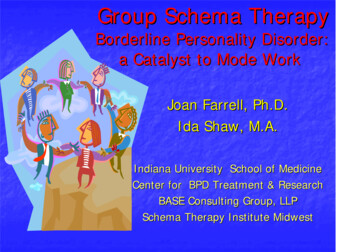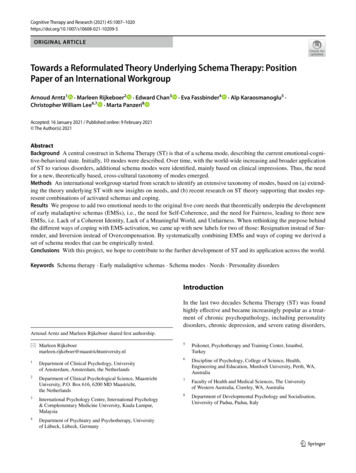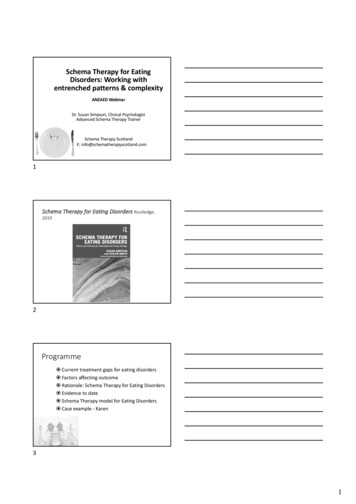
Transcription
Calvert et al. Journal of Eating Disorders (2018) 6:1DOI 10.1186/s40337-017-0185-8STUDY PROTOCOLOpen AccessGroup schema therapy for eating disorders:study protocolFiona Calvert1,2, Evelyn Smith2* , Rob Brockman3 and Susan Simpson4AbstractBackground: The treatment of eating disorders is a difficult endeavor, with only a relatively small proportion of clientsresponding to and completing standard cognitive behavioural therapy (CBT). Given the prevalence of co-morbidity andcomplex personality traits in this population, Schema Therapy has been identified as a potentially viable treatmentoption. A case series of Group Schema Therapy for Eating Disorders (ST-E-g) yielded positive findings and thestudy protocol outlined in this article aims to extend upon these preliminary findings to evaluate group Schema Therapyfor eating disorders in a larger sample (n 40).Methods/design: Participants undergo a two-hour assessment where they complete a number of standardquestionnaires and their diagnostic status is ascertained using the Eating Disorder Examination. Participantsthen commence treatment, which consists of 25 weekly group sessions lasting for 1.5 h and four individualsessions. Each group consists of five to eight participants and is facilitated by two therapists, at least one ofwho is a registered psychologist trained on schema therapy. The primary outcome in this study is eating disorder symptomseverity. Secondary outcomes include: cognitive schemas, self-objectification, general quality of life, self-compassion, schemamode presentations, and Personality Disorder features. Participants complete psychological measures and questionnaires atpre, post, six-month and 1-year follow-up.Discussion: This study will expand upon preliminary research into the efficacy of group Schema Therapy for individuals witheating disorders. If group Schema Therapy is shown to reduce eating disorder symptoms, it will hold considerable promise asan intervention option for a group of disorders that is typically difficult to treat.Trial registration: ACTRN12615001323516. Registered: 2/12/2015 (retrospectively registered, still recruiting).BackgroundThe treatment of eating disorders is a difficult endeavor,with only a relatively small proportion of clientsresponding to standard cognitive behavioural therapy(CBT). Less than half of those with bulimia nervosa(BN) have recovered at follow-up after receiving CBT[17, 18, 23] and research supporting cognitive-behaviouraltreatment for anorexia nervosa (AN) is limited, with noclear indication of improvement in this population [6, 8].Approximately 50% of patients with eating disorderscontinue to be highly symptomatic at 60-week follow-upfollowing transdiagnostic CBT [16]. Further, treatmentdropout rates are high amongst individuals with eatingdisorders [9, 43] with one literature review reporting an* Correspondence: evelyn.smith@westernsydney.edu.au2School of Social Sciences and Psychology, Western Sydney University, 1795Locked bag, Penrith, NSW, AustraliaFull list of author information is available at the end of the articleaverage drop-out rate of between 20 and 51% in inpatient settings and between 29 and 73% in outpatient settings [20].The treatment of eating disorders is especially complicated by a high level of co-morbidity [3]. Approximately69% of individuals with eating disorders may meet DSMIV (APA, 1994) diagnostic criteria for a personality disorder and 93% of these clients may also have other comorbidity including anxiety and substance use disorders.Eating disorders are also associated with the presence ofrigid personality features, which increases clinicalcomplexity and is associated with poorer treatment outcomes [22, 26, 46]. Eating disorders have also beenlinked to a range of trauma-related risk factors, including childhood abuse and neglect, which may also be mediated by personality disorder diagnoses [5]. Individualswith eating disorders also commonly experience complex and difficult-to-treat symptomatology including The Author(s). 2018 Open Access This article is distributed under the terms of the Creative Commons Attribution 4.0International License (http://creativecommons.org/licenses/by/4.0/), which permits unrestricted use, distribution, andreproduction in any medium, provided you give appropriate credit to the original author(s) and the source, provide a link tothe Creative Commons license, and indicate if changes were made. The Creative Commons Public Domain Dedication o/1.0/) applies to the data made available in this article, unless otherwise stated.
Calvert et al. Journal of Eating Disorders (2018) 6:1dissociation, perfectionism, compulsive pathology, rigidthinking patterns [28, 30, 38, 49] and high levels ofshame [7].Given the prevalence of co-morbidity and complexpersonality traits in this population, it is important toconsider the deeper belief systems underlying eating disorder presentations. Schema Therapy ([53]/1999) is becoming an increasingly popular psychological model forworking with individuals with complex mental healthand personality difficulties. Schema Therapy combinesaspects of cognitive, behavioral, experiential, interpersonal and psychoanalytic therapies into one integrativeand unified model [1]. The schemas that are targeted intreatment are enduring and self-defeating patterns thattypically begin early in life. These patterns consist ofnegative/dysfunctional thoughts and feelings which havebeen repeated and elaborated upon, and pose obstaclesfor accomplishing one’s goals and getting one’s needsmet [40]. These schemas are perpetuated behaviorallythrough the coping styles of schema maintenance,schema avoidance, and schema compensation. TheSchema therapy model of treatment is designed to helpthe person break these negative patterns of thinking,feeling and behaving and develop healthier alternativesto replace them [1].The evidence for schema therapy for individuals withcomplex mental health difficulties is growing. This approach has been applied, in both individual and groupforms, to a wide variety of clinical disorders, including,borderline personality disorder [19, 21] and chronic depression [11, 34, 41, 42]. A recent stringent systematicreview found medium to large effect sizes for schematherapy in the treatment of a range of psychological conditions [35]. Attention has recently been given to the applicability of Schema Therapy to individuals with eatingdisorders (Pugh, 2015). Evidence suggests that maladaptive schemas are more strongly held by individuals withanorexia and bulimia nervosa compared to normal controls [30]. Preliminary data [33, 38] supports the notionthat it is the schema processes that are engaged in an attempt to avoid intolerable emotional states associatedwith these schemas that in fact determine whether anindividual will manifest restrictive or bulimic eatingpathology. Whereas restrictive eating pathology may bea compulsive behavior developed to prevent schemas being triggered at all (schema compensation), bulimicpathology may function alongside other impulsive behaviors as a method of escaping schema-related affectonce schemas have already been triggered (schemaavoidance) [33, 38].Schema therapy has been used in individuals with eatingdisorders in one preliminary study [44]. Simpson et al. examined the use of Group Schema Therapy for EatingDisorders (STE-g) in a case series of eight participantsPage 2 of 7with chronic eating disorders and high levels of comorbidity. Treatment was comprised of 20 sessions whichincluded cognitive, experiential, and interpersonal strategies, with an emphasis on behavioral change. Clinicallysignificant change was observed from pre-treatment tosix-month follow-up for eating disorder severity (d 1.70),global schema severity (d 1.59), shame (d 0.91), andanxiety (d 1.53). Clinically significant change in eatingdisorder severity at follow-up was also shown for the majority of completers (six participants out of eight completed the full treatment program). Self-report feedbacksuggested that group factors may catalyze the changeprocess in schema therapy by increasing perceptions ofsupport and encouragement to take risks and try out newbehaviors, whilst providing a de-stigmatizing and deshaming therapeutic experience [44].The present study aims to extend upon the preliminaryfindings of Simpson et al. [44] to evaluate Schema Therapyin a large eating disordered sample (n 40), in terms of reduction of symptoms, and assess feasibility, acceptabilityand predictors of outcomes. We aim to conduct 6 groupsof schema therapy in two locations: 1) University of SouthAustralia in Adelaide Australia and 2) Western SydneyUniversity in Sydney Australia. The study will examinewhether Schema Therapy reduces eating disorder symptoms and improves psychological wellbeing and quality oflife, both at post treatment and follow-up.MethodParticipantsApproximately 40 participants will be recruited into thestudy. All participants will be females aged 18 years andover, meeting Diagnostic and Statistical Manual of MentalDisorders, 5th Edition criteria for an eating disorder, following a transdiagnostic approach (Fairburn, et al., 2003).Participants are recruited via word of mouth, letters to clinicians and advertisements through Facebook as well assupport organisations such as The Butterfly Foundation.Participants are provided with information about the studyand, if they agree to participate, are required to give writtenconsent. Full disclosure of the purpose of the study, the potential benefits and risks associated with participation, andthe confidential nature of information obtained in the studyis explained to participants.Inclusion/ exclusion criteriaParticipants with active psychotic symptoms, high suicide risk or current crisis status (self-disclosed at baseline), a BMI of less than 14, intellectual disability, andthose who are consuming large amounts of alcohol/drugs are excluded from the study. All participants musthave a general practitioner involved in their care tomonitor their physical health in order to participate inthis research.
Calvert et al. Journal of Eating Disorders (2018) 6:1Page 3 of 7Overall study designThis study will be an uncontrolled single group repeatedmeasures design. Ethics approval was secured andparticipants provided informed consent to participate.Participants are first screened over the phone to ensuresuitability for the group. If they agree to participate inthe group, they then undergo a two-hour assessmentwhere they complete a number of standard questionnaires and their diagnostic status is ascertained. Participants then commence treatment which consists of 25weekly group sessions lasting for 1.5 h. Participants arealso provided with four individual sessions that they canbook with one of the therapists whenever they want.Each group consists of six to eight participants and isfacilitated by two therapists, at least one of whom is aregistered psychologist with training on schema therapy,and supervised by a schema therapist. Participantscomplete psychological measures and questionnaires atpre, post, 6 month and 1 year follow-up.MeasuresThis study utilises a battery of assessments conducted atbaseline, mid-treatment, end-of-treatment, and six- andtwelve-month follow-up points. These assessments areconducted by fully registered psychologists who have received specialized training in the administration of standardized eating disorder measures. Table 1. Provides asummary of these assessments.Eating Disorder Examination (EDE; [15])The EDE is a structured, investigator-based interviewthat measures the severity of symptoms of eating disorders. The scale can be used to ascertain an individual’seating disorder diagnosis, as is the purpose of theTable 1 Assessments conducted at different time pointsMeasureBaselineEDExEDE-QxWeeklyMidPost6 months12 monthsxxxx xSCS-SFxxxxxSATAQxxxxxxxMCMI-IIIxxBSL-23xxmeasure in the current study. The EDE has been shownto have excellent reliability when administered bytrained examiners [12].Eating Disorder Examination- Self-Report Questionnaire Version(EDE-Q; [14])The EDE-Q is a 36-item self-report questionnaire forthe assessment and diagnosis of eating disorders. TheEDE-Q yields four subscale scores—Restraint, EatingConcern, Weight Concern, and Shape Concern—as wellas a global score, which is an average of all four subscales. The EDE-Q has been shown to have goodconvergent validity [10, 14]. Acceptable internalconsistency and test–retest reliability have also beendemonstrated [32, 37].Young Schema Inventory- Short Form (YSQ-SF; [52])The YSQ-SF is a self-report measure used to assess 15different maladaptive schemas (emotional deprivation,abandonment, mistrust/abuse, social alienation, defectiveness, incompetence, dependency, vulnerability to harm,enmeshment, subjugation of needs, self-sacrifice, emotional inhibition, unrelenting standards, entitlement, andinsufficient self-control). The scale consists of 75 itemsrated from one (completely untrue of me) to six (describesme perfectly). The scale has been shown to have good psychometric properties [25, 50].Schema Mode Inventory-Short Form (SMI; [31])The SMI measures the presence of 14 schemas modes:Vulnerable Child, Angry Child, Enraged Child, ImpulsiveChild, Undisciplined Child, Happy Child, CompliantSurrender, Detached Protector, Detached Self-Soother,Self-Aggrandizer, Bully and Attack, Punitive Parent,Demanding Parent and Healthy Adult modes. The questionnaire consists of 118 items which are given frequency ratings using a Likert scale ranging from one(never or hardly ever) to six (always). An overall score iscalculated from the scale sum score divided by the number of items in that scale. The short form of the SMI hasbeen shown to have acceptable internal consistenciesamongst the 14 subscales (Cronbach α’s from .79 to .96)as well as adequate test-retest reliability and moderateconstruct validity [31].World Health Organisation-Five Well-Being Index (WHO-5; [51])Notes: EDE Eating Disorder Examination; EDE-Q Eating Disorder ExaminationQuestionnaire; YSQ-SF Young Schema Questionnaire, short form; SMI SchemaMode Inventory; WHO-5 World Health Organisation-Five Well-Being Index;CORE-10 Clinical Outcomes in Routine Evaluation-Outcome Measure; SCS Self-Compassion Scale- Short Form; SATAQ Sociocultural Attitudes TowardsAppearance Questionnaire; MCMI-III Millon Clinical Multiaxial Inventory- III;BSL-23 Borderline Symptoms ListThe WHO-5 is an assessment of general wellbeing consisting of five statements (e.g. I have felt cheerful and ingood spirits and I have felt calm and relaxed), which participants rate on a six-point scale (from never to always),with a possible total score varying from 0 to 25. Higherscores on the WHO-5 reflect better well-being.
Calvert et al. Journal of Eating Disorders (2018) 6:1Clinical Outcomes in Routine Evaluation-Outcome Measure(CORE-10; [2])The CORE-10 is a self-report measure of generalpsychological distress. The CORE-10 includes 10-itemswhich the respondent rates on a five-point Likert scale(from not at all to most or all of the time), for example Ihave felt tense, anxious or nervous and I have felt panicor terror. The CORE-10 has been shown to have goodinternal reliability (α .90) and a correlation of.94 withthe CORE-OM [2].Self-Compassion Scale- Short Form (SCS-SF; [39])The SCS-SF is a 12-item, self-report scale which assessesthe positive and negative aspects of the three main components of self-compassion: Self-Kindness (e.g., WhenI’m going through a very hard time, I give myself the caring and tenderness I need) versus Self-Judgment (e.g.,I’m disapproving and judgmental about my own flawsand inadequacies); Common Humanity (e.g., When I feelinadequate in some way, I try to remind myself that feelings of inadequacy are shared by most people) versus Isolation (e.g., When I fail at something that’s important tome, I tend to feel alone in my failure); and Mindfulness(When something upsets me I try to keep my emotions inbalance) versus Over-Identification (When I’m feelingdown I tend to obsess and fixate on everything that’swrong). Responses are given on a five-point scale rangingfrom one (almost never) to five (almost always). A totalself-compassion score is calculated as a mean of allitems and higher scores correspond to higher levels ofself-compassion. The SCS-SF has good psychometricproperties, with high internal consistency (α .85; [45])and a very high correlation with the long form of theSCS [39].Sociocultural Attitudes Towards Appearance QuestionnaireInternalization subscale (SATAQ; [24])The SATAQ is a 14-item inventory assesses women’srecognition and acceptance of societally prescribed standards of physical appearance, particularly the thin ideal.The 8-item Internalization subscale is used in thepresent study and measures the extent to which the individual personally accepts these standards. Statementssuch as I tend to compare my body to people in magazines and on TV are rated from one (completely disagree)to five (completely agree). The SATAQ converges satisfactorily with other measures of body image and eatingdisturbance [24, 47].Millon Clinical Multiaxial Inventory- III [36]The MCMI-III is a psychological assessment that provides information on longstanding personality patternsand clinical symptomatology. The tool consists of 175items that are scored on a True/False basis that arePage 4 of 7scored to produce 28 clinical subscales. Reliability andvalidity studies on the MCMI indicate that is generally apsychometrically sound instrument. The scale demonstrates good internal consistency with alpha coefficients of above.80 for the majority of the scales(manual). Test-retest reliability has been shown to bemoderate to high [13, 29].Borderline Symptoms List (BSL-23; [4])The BSL-23 is a questionnaire used to assess the degreeof symptoms of BPD, such as poor self-esteem,dysphoric emotions, suicidal intention and impulsive behaviors. The scale consists of 23 items (for example: Iexperienced stressful inner tension and I wanted to punish myself ) rated on a five-point Likert scale from 0 (notat all) to 4 (very strong). A total score is obtained bysumming responses and higher scores represent moresevere BPD symptomatology. The BSL-23 has goodpsychometric properties with high internal consistency(α 0.94–0.97) and the ability to discriminate personalitydisorder patients from patients with other clinical symptomatology (mean effect size of 1.13; [4]).Primary outcomesEating disorder symptom severity is the primary outcome of this, as measured by the EDE and EDE-Q. TheEDE will be used for pre to post, but due to limited resources only the EDE-Q will be completed at follow-up.Secondary outcomesThe secondary outcomes measured in this study include: cognitive schemas (measured using the YSQ);self-objectification (measured using the SATAQInternalisation); general quality of life (WHO-5 andCORE-10); self-compassion (SCS-SF); schema modepresentations (measured using the SMI); and Personality Disorder features (measured using the MCMI-IIIand the BSL-23).InterventionThe schema therapy eating disorder group (STE-g; [44])was based on the schema mode model, with somecomponents drawing on the schema-therapy treatmentprogram: “Schema Focused Therapy in a Group Setting”[48]. The program consists of twenty-five 90-minsessions. All participants are provided with a patientversion workbook which corresponds with the treatmentmanual. The first part of the group focuses on schemapsychoeducation and schema-focused cognitive behavioral strategies which help participants to identify andstart challenging their schemas, whilst working on behavioral change both within and outside the group. Thismodel assists participants to develop an individualisedformulation of their own difficulties using a schema
Calvert et al. Journal of Eating Disorders (2018) 6:1therapy framework. The highest schemas and modes areidentified for each patient on the basis of their scores onrelevant measures. Each session is recorded and groupmembers are strongly encouraged to come in to watchthe video should they miss a session. This is to ensurethat participants do not miss any educational material,and retain a sense of connectedness with the group.Particular emphasis is placed on linking eating behaviors to the schema modes, so that participants are ableto learn about the origins and coping functions associated with their own pattern of symptoms. Avoidant coping in the group is addressed frequently by labeling the“Detached Protector” mode when it is identified eitherby group leaders or by other participants (i.e., both inthe context of the group and when talking about eatingbehavior which took place between sessions). Use ofover-compensatory behaviors to avoid emotions is alsoidentified and group members are encouraged to pointthis out to each other empathically as the group progresses. Due to the lack of emotional awareness andemotional tolerance within the group, participants areencouraged to learn to express empathy and to ask fortheir emotional needs to be met within the context ofthe group, rather than detaching from emotional needsthrough eating behaviors. Schema-focused mindfulnessmeditation [27], is incorporated to increase awareness ofurges to carry out eating disordered behaviors, modesand associated triggers and to facilitate emotionalregulation.Participants are helped to identify the origins of theirnegative body-image, and to link these to the development of particular modes. Body-image restructuringwork involves participants learning to recognise theway in which their perception and visceral sense oftheir bodies differs from the perspective of their mostprominent modes, and developing a compassionate“Healthy Adult” mode which is accepting and nurturingtoward the body. Mode dialogues are used to enablegroup members to repeatedly coach each other to sendthe “Critical” mode away when it expresses negative assertions about the body or self (e.g. “You are ugly, fat,and nobody really likes you”). This gives group participants the opportunity to practice being in HealthyAdult mode firstly for others and then for themselves.Flashcards are used to reinforce what is learned in sessions and to help participants to challenge modes andresist eating disordered behavior between sessions. Inthe four individual sessions the therapist ensure thatthe participant understand the schema model, managescrisis, and engages in schema therapy.Data analysisWithin-patient standardized effect size information (i.e.,Cohen’s d) from baseline to end-of-treatment, and fromPage 5 of 7baseline to follow-up will be calculated for eating psychopathology, and all secondary outcomes. Clinical outcome data will be analysed using intention to treatcriteria. Data from outcome measures will be analysedwith paired sample T-test. To assess group differencesbetween the two treatment sites, independent t-tests willbe used. The effect size of outcome measures will becompared to the effect size reported for previous studiesCBT for eating disorders. The criterion used for statistical significance will be p 0.05. Sample size was estimated assuming 80% power, significance level at 0.05,and an effect size of 0.5; 26 people are needed. Assuminga 50% drop out as documented in previous CBT trials, wewill need around 40 people.At the completion of the treatment, a random set ofparticipants will be invited to provide qualitative feedback on their experiences of the group treatment. Theseinterviews will be one-to-one, and conducted eitherface-to-face, or via telephone, and are expected to lastfor between 30 and 60 min. Transcripts of these interviews will be made and the data will be analysed using athematic analyses approach. This information will beused to provide preliminary information about treatmentefficacy and acceptability, and inform the design offuture studies.DiscussionThis study will expand upon preliminary research ofgroup Schema Therapy for individuals with eating disorders [44]. If group Schema Therapy is shown to reducesymptoms for this population, it will hold considerablepromise as an intervention option for a group of disorders that is typically difficult to treat.As this is an uncontrolled study it is limited by nothaving a proper comparison to control for confoundingvariables. We initially designed this study with a controlgroup, group Cognitive Behaviour Therapy (CBT), butthen were unable to recruit participants for the CBTgroup in Adelaide, and participants only wanted to takepart of the research if they were in the schema therapygroup. This was mostly due to the fact that Adelaide is asmall city and referrals were usually received for severecases, as most of the participants so far had completedCBT before. We do wish to conduct a randomized controlled trial comparing schema therapy to CBT, but thatwill need to be conducted in Sydney.Since the groups are transdiagnostic this has a few advantages and disadvantages. First, the transdiagnostic approach for eating disorders is well established, it helpshaving different eating disorders as this will provide variety in the group on schemas and modes, which mightfacilitate engagement. However, within the group peoplemight feel very dissimilar to each other within a transdiagnostic approach, and the psychologists running the
Calvert et al. Journal of Eating Disorders (2018) 6:1groups will keep this in mind to bring unity to the groupby articulating commonalities among participants.This study will be the first to modify schema therapy to fit the eating disorders sample and to deliverit to this group. This uncontrolled study will establishproof of concept and assess feasibility, acceptabilityand potential harms. To date, the study has completed four 25-week group treatments and has commenced a further two groups.AcknowledgementsWe would like to thank Western Sydney University for the funding for thisstudy, titled Western Sydney University Women’s Fellowship. We would alsolike to thank the participants and the psychologists involved in this study(Sharon Stern, Claudia Mendez, Charlotte Whittingham, Kate Veremeenko,Penelope Richards, Sally-ann Skewes, Rachel Samson, Nicole Middleton).Authors’ contributionsES and SS designed the treatment protocol and secured ethics; RB reviewedthe protocol; FC wrote the first draft; ES, SS and RB edited the manuscript.All authors read and approved the final manuscript.Competing interestsThe authors declare they have no competing interests.Publisher’s NoteSpringer Nature remains neutral with regard to jurisdictional claims inpublished maps and institutional affiliations.Author details1School of Psychology, University of Wollongong, Wollongong, NSW,Australia. 2School of Social Sciences and Psychology, Western SydneyUniversity, 1795 Locked bag, Penrith, NSW, Australia. 3University ofTechnology Sydney, Ultimo, NSW, Australia. 4School of Psychology, SocialWork & Social Policy, University of South Australia, Adelaide, SA, Australia.Received: 21 August 2017 Accepted: 13 December 2017References1. Bamelis LLM, Evers SMAA, Spinhoven P, Arntz AR. Results of a multicenterrandomized controlled trial of the clinical effectiveness of schema therapyfor personality disorders. Am J Psychiatr. 2014;171:305–22.2. Barkham M, Bewick B, Mullin T, Gilbody S, Connell J, Cahill J, Evans C. The CORE10: a short measure of psychological distress for routine use in the psychologicaltherapies. Counselling and Psychotherapy Research: Linking research withPractice. 2013;13:3–13. https://doi.org/10.1080/14733145.2012.729069.3. Blinder BJ, Cumella EJ, Sanathara VA. Psychiatric comorbidities of femaleinpatients with eating disorders. Psychosom Med. 2006;68:454–62.4. Bohus M, Kleindienst N, Limberger M, Stieglitz R, Domsalla M, Chapman A,Wolf M. The short version of the borderline symptom list (BSL-23): developmentand initial data on psychometric properties. Psychopathology. 2009;42:32–9.5. Brewerton TD. Eating disorders, trauma and comorbidity: focus on PTSD.Eat Disord. 2007;15:285–304.6. Bulik C, Berkman N, Brownley K, Sedway J, Lohr K. Anorexia nervosatreatment: a systematic review of randomized controlled trials. Int J EatDisord. 2007;40:310–20.7. Burney J, Irwin HJ. Shame and guilt in women with eating-disordersymptomatology. J Clin Psychol. 2000;56:51–61.8. Byrne S, Wade T, Hay P, Touyz S, Fairburn C, Treasure J, Schmidt U, McIntosh V,Allen K, Fursland A, Crosby R. A randomised controlled trial of threepsychological treatments for anorexia nervosa. Psychol Med. 349. [Epub ahead of print]PubMed PMID:28552083.9. Campbell M. Drop-out from treatment for the eating disorders: a problemfor clinicians and researchers. Eur Eat Disord Rev. 2009;17:239–42.10. Carter J, Aime A, Mills J. Assessment of bulimia nervosa: a comparison ofinterview and self-report questionnaire methods. Int J Eat Disord. 2001;30:187–92.Page 6 of 711. Carter J, McIntosh V, Jordan J, Porter R, Frampton C, Joyce P. Psychotherapyfor depression: a randomized clinical trial comparing schema therapy andcognitive behavior therapy. J Affect Disord. 2013;151:500–5.12. Cooper Z, Cooper P, Fairburn C. The validity of the eating disorder examinationand its subscales. Br J Psychiatry. 1989;154:807–12.13. Craig RJ. Overview and status of the Millon clinical multiaxial inventory.J Pers Assess. 1999;72:390–406.14. Fairburn CG, Beglin SJ. Assessment of eating disorders: interview or self-reportquestionnaire? Int J Eat Disord. 1994;16:363–70.15. Fairburn CG, Cooper Z. The eating disorder examination (twelfth edition). In:Wilson CGFGT, editor. Binge eating: nature, assessment and treatment. NewYork: Guilford Press; 1993. p. 317–60.16. Fairburn CG, Cooper Z, Doll HA, O'Connor ME, Bohn K, Hawker DM, PalmerRL. Transd
personality traits in this population, it is important to consider the deeper belief systems underlying eating dis-order presentations. Schema Therapy ([53]/1999) is be-coming an increasingly popular psychological model for working with individuals with complex mental health and personality difficulties. Schema Therapy combines
